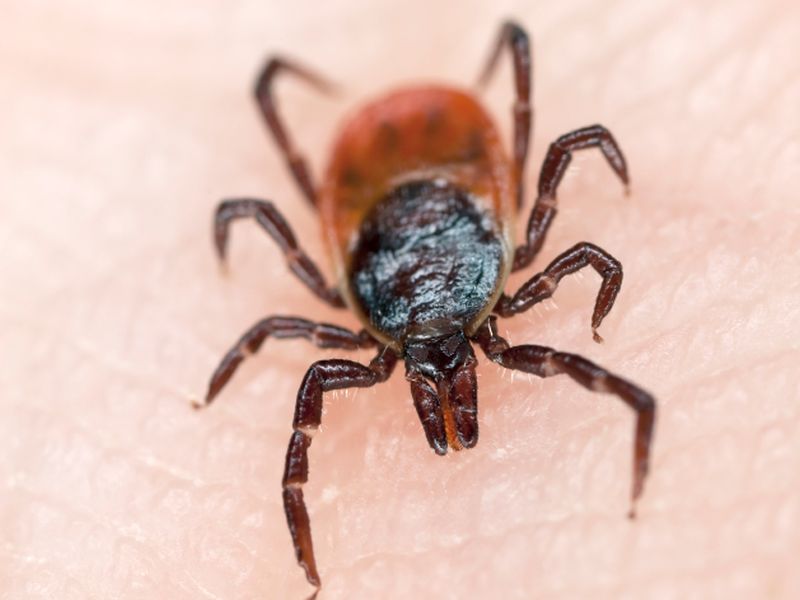TUESDAY, July 17, 2018 (HealthDay News) — As the tick population surges across the United States this summer, one doctor says the best way to avoid being infected with the nasty illnesses the tiny bugs carry is to wear protective clothing and to check your body thoroughly after every trip into the woods.
Just last week, a new study found that ticks have spread far and wide in recent years, and they are now being reported in areas that had never seen ticks before. Even worse, these nasty critters carry bacteria and parasites that cause serious diseases, including Lyme and babesiosis.
All told, disease-carrying ticks were detected in 83 counties across 24 states where they’d never been found before.
“People should be aware of ticks and tick-borne disease, even when they may think there’s not a recorded incidence of a tick in a county,” said study author Nate Nieto, an associate professor with Northern Arizona University’s department of biological sciences. “These things, they’re not obeying borders. They’re going by biology. If they get moved there by a deer or bird or people or pets, they’re going to establish themselves and start growing.”
And with more ticks comes more disease.
In May, the U.S. Centers for Disease Control and Prevention reported that illnesses spread by ticks doubled between 2004 and 2016.
Why the big jump?
According to Dr. Robert Glatter, an emergency physician at Lenox Hill Hospital in New York City, “The current surge in tick-borne diseases is a result of a combination of factors, including a much shorter and milder winter, combined with a greater number of acorns produced by oak trees, which has, in turn, increased the food supply for mice and other rodents which serve as hosts for these ticks.”
So, how can you still enjoy nature?
“The fact that we don’t have a vaccine for eliminating tick-borne diseases means that we have to take extra precautions to avoid exposure to them in our environment,” Glatter stressed.
“It’s important to check for ticks in places on your body that you may not consider,” he noted. “This includes behind the knee, especially after you go hiking in the woods or horseback riding.”
And there are even more unusual places on your body to consider and check.
“In one patient who was having persistent facial pain and congestion, I discovered and removed a tick in her nose. It’s certainly not a common place to find an embedded tick, but it’s not impossible, since ticks seek shelter and warm areas to hide,” Glatter explained.
“I also have removed ticks on the buttocks, and in other cases on the labia of the vagina as well as on the scrotum and shaft of the penis,” he added. “In these cases, people were sitting and frolicking in wooded or grassy areas, often just wearing bathing suits or shorts without undergarments.”
Even the belly button is not safe from a tick bite. And routine checks of the ears, scalp, ankles and lower legs are always wise, Glatter said.
“I have also removed ticks between patients’ toes after walking barefoot in the woods,” he added. “I would recommend that people not walk barefoot in the woods for this simple reason, in addition to the risk of sustaining a puncture or injury to the foot as well.”
Even your backyard might not be a safe place, though ticks tend to prefer woods and grassy areas.
“The only surefire way to prevent tickborne disease is to reduce the risk of getting tick bites,” Glatter stressed. “I recommend using insect repellent, DEET (at least 20 percent) and wearing long sleeves and pants as protective measures against ticks if you are gardening, hiking or walking in the woods. Also, avoid sitting on stone walls and grassy areas.”
It’s even smarter to apply a repellent such as permethrin to socks, boots, pants and tents, he added. While DEET can only repel ticks, permethrin actually kills them within 10 to 30 seconds of exposure.
And don’t forget to check your pets after every outing. If you see ticks, remove them whenever possible using a tweezer, to prevent any embedded tick body parts from being left behind, Glatter said.
If you are bitten by a tick, you should see a doctor who can test you for Lyme disease, according to the U.S. Centers for Disease Control and Prevention.
More information
Visit the U.S. Centers for Disease Control and Prevention for more on ticks.
Copyright © 2025 HealthDay. All rights reserved.

